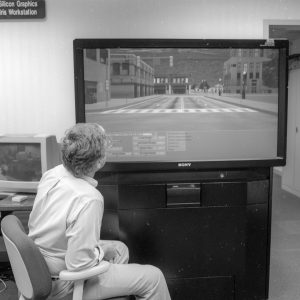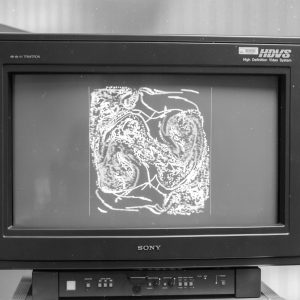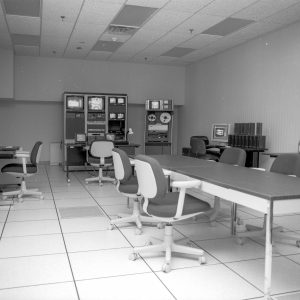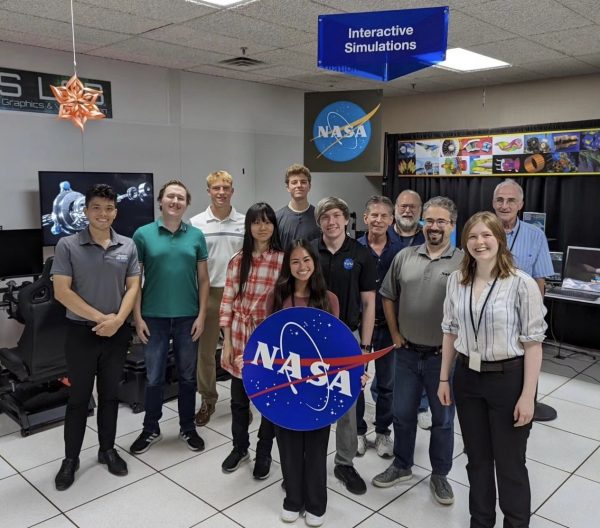About GVIS
As part of NASA Glenn’s Scientific Computing and Visualization Team, the GVIS Lab has a storied visual and technological history.
Our History
The ICARE Era
It all started in 1982 when a 20 million dollar supercomputer was brought to NASA’s Glenn Research Center. Scientists at NASA Glenn were becoming increasingly reliant on computer simulations to test their experiments. Advancements in computer technology allowed a different type of testing environment — one that revolved around virtual models and data over physical observation. The benefits of this method included a decrease in costs, a decrease in associated risk, faster turnaround, and more data.
But this method of experimentation created a problem: With data-point counts somewhere in the millions, it was a challenge for scientists to even begin to look at their own collected data. In short, there was simply too much data to be analyzed. To solve this problem, NASA Glenn built the Interactive Computer Aided Research Engineering system (ICARE) in their Research Analysis Center. Taking up several rooms, consisting of 22 total work stations, and costing a grand total of 20 million dollars, the ICARE system was a way for scientists to examine their data through the aid of supercomputer visualizations. Utilizing both graphical and modular methods, ICARE’s visualizations revealed and shared information in ways that traditional analyzations could not match.
The construction and implementation of the ICARE system was revolutionary to both the Glenn Research Center and NASA as a whole. Before 1982, NASA already had an established interest in powerful computers, however the ICARE system took NASA into the era of supercomputing. ICARE also brought increased attention to the value and power of scientific visualization.
The Creation of GVIS
In 1989 it was time for an upgrade. NASA Glenn wanted the latest scientific visualization technology and techniques for its scientists, so the Research Analysis Center was expanded to make room for the new Graphics and Visualization Lab (GVIS). The GVIS Lab acquired cutting-edge graphics technology, including studio quality TV animation and recording equipment, stereographic displays, and image processing systems. Later, the High Performance Computing Act of 1991 provided funding and opportunities to add high-speed computing, virtual reality, and collaborative visualization to its fleet of tools.
At this period in our history, the GVIS Lab was responsible for helping any and all NASA Glenn scientists who needed help visualizing their data. The Lab was also tasked with inventing new visualization techniques and promoting NASA Glenn’s activities though tours, videos, and other outreach programs. Some of the techniques the Lab developed include: particle tracking, iso-surface contours, and volume visualization. Tour guests included school children, corporate VIPs, local and national politicians, TV news media, and researchers from other national labs. Utilizing our state-of-the-art recording and editing hardware, the GVIS Lab regularly shared work both inside and outside of NASA.
As other labs and researchers began to gain access to their own scientific visualization tools, the GVIS Lab shifted its focus to experimenting with virtual reality and augmented reality based visualizations.
GVIS Now
Today, the GVIS Lab has the same mission that we had in 1989: to apply the latest visualization and human interaction technologies to advance NASA’s missions. We still take pride in pushing the limits of scientific visualization and computer science, helping our fellow researchers make sense of their data, and inspiring the next generation through our demonstrations and presentations. Computational technology has come a long way since the days of ICARE, but that has not stopped us from keeping up with what is current and cutting-edge.
In addition to scientific visualization and experimental computational technologies, we now also specialize in virtual design, interactive 3D simulations, natural user interface development, applications of computer science, and mission scenario visualizations. We utilize the latest edition of 3D modeling and animation programs, such as Blender, Houdini, and Unity, to build and design our interactive applications. Virtual reality headsets, augmented reality headsets, Leap Motion sensors, Xbox Kinects, and various other hardware and software are now also at our fingertips. Besides experimenting with how these systems can be used to visualize data, we also push their input and output capabilities to their limits.
With all this technology, we also support the visualization of a wide variety of 3D data and models such as CAD, point clouds, and volume data. Additionally, we are capable of high-impact data visualization, web-based visualization, time-accurate data representation, and designing and testing CAD models in virtual reality.
Continued Outreach
Outside of the lab, GVIS takes its technology demonstrations across town, throughout the country, and around the world. We have extensive experience with organizing, presenting, and facilitating STEM-based educational outreach for a variety of different events and venues. Additionally, we take pride in our ability to connect with the public and inspire them with the latest and greatest NASA technology and news. We support all six of NASA Glenn’s Core Competencies and all four of NASA’s main mission directives in their quest to benefit humanity and explore worlds beyond our own.
Inside the Lab, we support the education and career exploration of our high school and college interns through mentorship, community engagement opportunities, and the access to cutting edge technology.
Fun Facts
- The GVIS Lab had the first HD video animation system in Cleveland
- We are the first place in Ohio to have virtual reality systems with head-mounted displays
- We are the first facility in Cleveland to have high-speed frame buffers connected to a supercomputer
- We are also the first facility in Ohio to possess a Computer Automatic Virtual Environment (CAVE)
- We are one of the first VR labs to ever exist
Contact Us!
Need to reach us? You can directly send an email to the GVIS Team GRC-DL-GVIS@mail.nasa.gov or the Team Leader, Herb Schilling hschilling@nasa.gov
Like our content? Follow us on social media @nasa_gvis on Twitter and Instagram!





